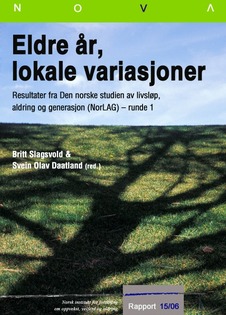| dc.contributor.author | Daatland, Svein Olav | |
| dc.contributor.author | Slagsvold, Britt | |
| dc.date.accessioned | 2020-06-07T21:05:13Z | |
| dc.date.accessioned | 2021-04-29T13:50:46Z | |
| dc.date.available | 2020-06-07T21:05:13Z | |
| dc.date.available | 2021-04-29T13:50:46Z | |
| dc.date.issued | 2006 | |
| dc.identifier.isbn | 82-7894-244-7 | |
| dc.identifier.issn | 0808-5013 | |
| dc.identifier.uri | https://hdl.handle.net/20.500.12199/3225 | |
| dc.description.abstract | The focus is in this report on local variation in older years - how ageing and later life is played out in, and influenced by, local surroundings. The Norwegian Life-Course, Ageing and Generation Study (NorLAG) is based on samples (n=around 5 500, aged 40-79) from 30 municipalities which represent a variety of places and spaces all over the country. The introductory chapter 1 and the concluding chapter 11 summarize the conceptual perspectives, which are explored empirically in the other chapters. The study and the local communities are presented in chapters 2 and 3. Chapter 4 discusses local variation in physical health. Chapter 5-7 follow up with analyses of individual and local variation in mental health, loneliness, and quality of life (life satisfaction). There is considerable variation on these dimension between the communities, but mainly because of population characteristics (compositional factors). Mental health problems are considerable, mainly in terms of depression symptoms, and then more so among women than men, and among older more than middle aged persons. Anxiety varies less with age. Risks for loneliness is related to health and social networks more than to contextual factors. Subjective age and ageing is the theme in chapter 8, showing moderate local variation, but considerable variation according to age and gender. The majority feel younger than they are, and want to be even younger, and increasingly so the older one gets. The causes and consequences of negative ageing identities like these are discussed, including why men seem to be more negative to ageing than women. Chapter 9 presents family patterns, and chapter 10 work and retirement patterns in the second half of life, in both cases with considerable local variation, but with even more variation according to personal and social resources. Family resources are unevenly distributed, and although intergenerational solidarity seems strong, growing divorce trends are risk factors, in particular for divorced fathers. Retirement increases from age 60 onwards, but with considerable variation according to education, and opportunity - quite a few want to prolong their working career when possible. | en |
| dc.description.abstract | Rapporten tar for seg hvorvidt og hvordan lokale og stedlige kvaliteter virker inn på kvinners og menns livsløp og aldring. De teoretiske perspektivene blir oppsummert i et innledende og avsluttende kapittel. De øvrige kapitlene tar for seg individuell og lokal variasjon i fysisk og mental helse, familierelasjoner, livskvalitet, aldersidentiteter og arbeids- og pensjoneringsmønstre. Det er betydelige forskjeller mellom kommuner på disse områdene, som ser ut til å skyldes sammensetningen av befolkningen (komposisjonelle forhold) mer enn karakteristika ved lokalsamfunnene (kontektstuelle forhold). Stedstilknytning ser ut til å være viktig for mange, især i eldre år. Utgangspunktet for rapporten er Den norske studien av livsløp, aldring og generasjon (NorLAG), der vi har intervjuet mer enn 5 500 personer i alderen 40-79 år om livsvilkår og livsformer i andre halvdelen av livet. Utvalget ble trukket fra 30 kommuner og bydeler som representerer et tverrsnitt av store og små lokalsamfunn i ulike deler av landet. Kapitlene er skrevet av medlemmene av forskergruppen, og rapporten er redigert av Britt Slagsvold (prosjektleder) og Svein Olav Daatland. | no_NB |
| dc.publisher | Oslo Metropolitan University - OsloMet: NOVA | |
| dc.relation.ispartofseries | NOVA Rapport 15/06 | |
| dc.subject | NOVA | |
| dc.title | Eldre år, lokale variasjoner | no_NB |
| dc.type | Report | |
| fagarkivet.author.link | https://www.oslomet.no/om/ansatt/sodaat | |
| fagarkivet.author.link | https://www.oslomet.no/om/ansatt/bslag | |
| fagarkivet.source.pagenumber | 193 | |
